Dell Solutions Forum 2015: how it was
Hello, Habr! As you may recall, in October we held our next, for the fourth in a row, Dell Solutions Forum 2015 in Moscow, the largest annual event for customers and partners.
As in the past year , we want to tell those of you who could not attend it (but really wanted to) what was happening there. Those of you who spent the whole day with us on October 21 at the Radisson Slavyanskaya Hotel are encouraged to share their impressions of the forum in the comments.
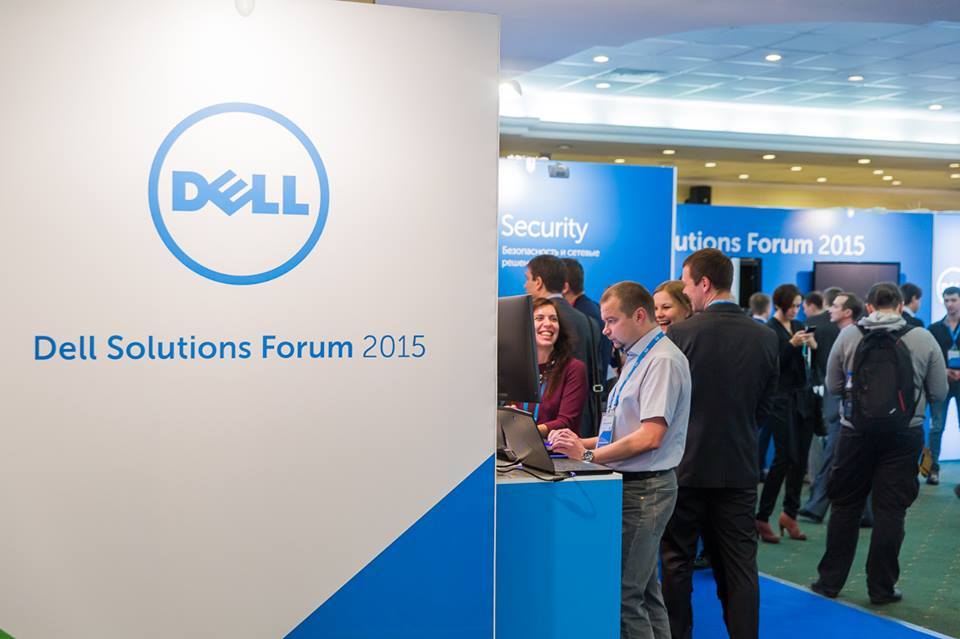
So, we invite everyone under the cat.
Even in this difficult year for all, the Forum of Solutions brought together more than 770 participants. Its sponsors are key technology partners of the company.including Intel and Microsoft. Citrix, Nvidia, VMware, Compulink, IBS Platformix, Softline and CROC also participated in the conference and exhibition.
The Moscow forum is being held as part of a series of Dell Solutions Tour 2015 events . They cover 17 countries. Speakers at the forum, and these are representatives of Dell, its partners and customers, talk about market trends, innovations and new products of the company. The goal of this event is to tell everyone about the wide range of Dell solutions that help enterprises not only optimize their existing infrastructure, but also prepare it for future growth and tomorrow's needs. Even the global marketing campaign we launched this year was called Future Ready Enterprise, and the forum itself was held under the slogan “IT: a step into the future”.
In the film "Back to the Future - 2", the time machine transfers the protagonist precisely on October 21, 2015. This distant future seemed to the creators of the picture saturated with high-tech devices and devices, which then could only be dreamed of. The reality of 2015, of course, is different from what it was seen by director Robert Zemeckis in 1985. Flying cars and skateboards have not yet received such a distribution. But many modern technologies 30 years ago were even hard to imagine.

The main areas that determine the present and future of IT, we include technologies for cloud computing, systems to ensure employee mobility, tools to protect corporate data and user systems, technologies for working with Big data (processing, analytics and storage). So many industry experts and analysts say. Around these topics the forum program of this year was built .
By tradition, the Dell Solution Forum was opened by Boris Scherbakov, Dell's CEO in Russia, Kazakhstan and Central Asia.
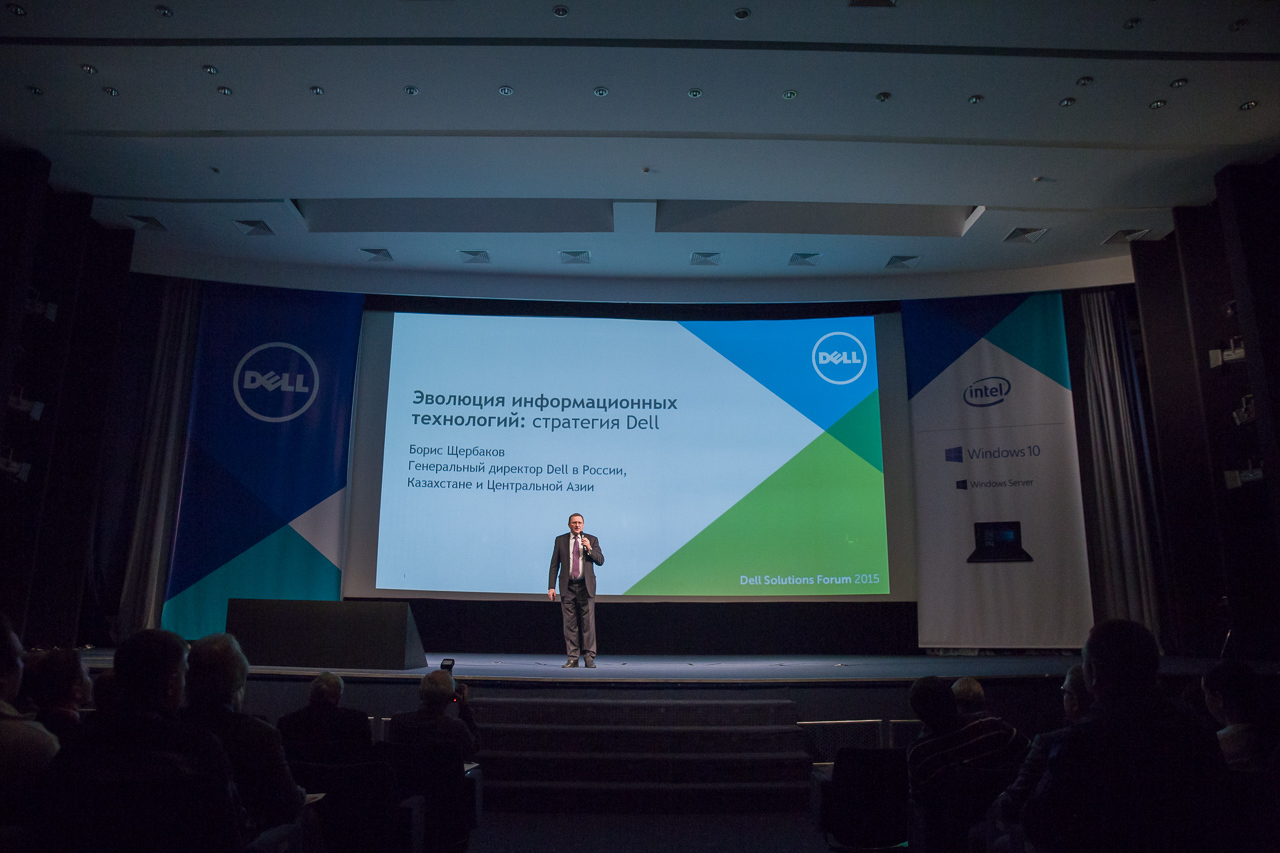
Two years ago, Dell, becoming a private company, got the opportunity to invest in the future - its head Michael Dell, who considers it necessary to "build a business on the needs of customers", "deployed the company to the customer."
In 2007, Michael Dell returned to the post of CEO and began transforming the corporation, spending billions of dollars to buy more than 30 companies specializing in a wide variety of fields - from networks and storage systems to software, security and clouds. Dell has begun to invest more in research and development.
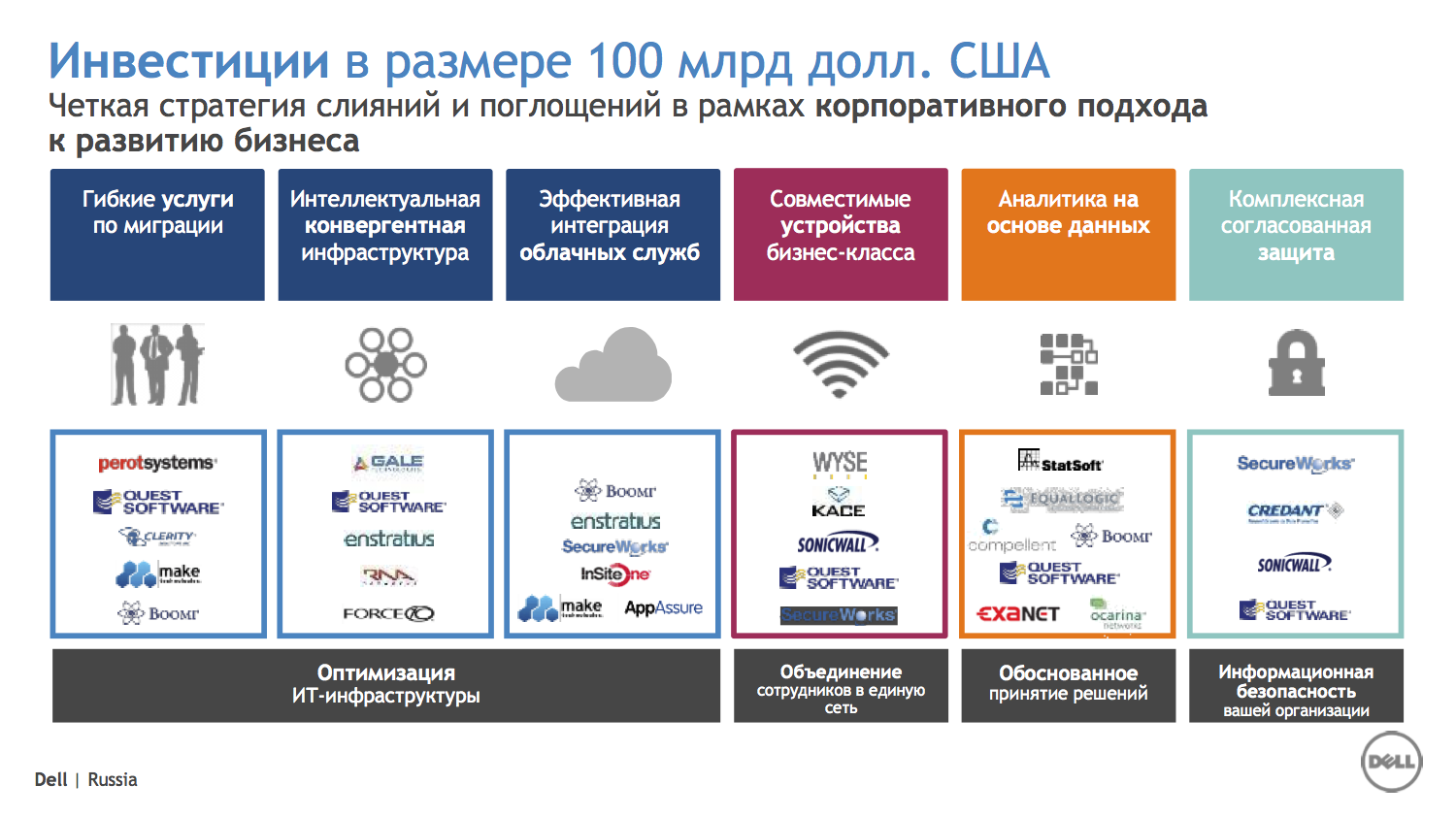
A little about the recent successes of Dell: Gartner has included Dell among the "visionaries" in the network infrastructure of the data center. In addition, in 2014, Dell received more technology patents than in its entire history, and with its Wyse solutions, it came out on top in the global job virtualization market (VDI).
The results of Dell’s IT development activities have led to first place in high-density solutions, iSCSI devices, server virtualization, and support for the largest cloud services. Dell software is now used by 90% of Fortune 1000 companies.
It would be a long time to list all the company's achievements, but they are in the pictures and in the customer address ( Dell 2015 Annual Report to Customers ) - in pictures!
Dell offers are designed for varying degrees of "technological maturity" of customers, their willingness to introduce new technologies. A differentiated approach to customers means that they are offered both traditional and new technologies, such as software-defined and cloud solutions, Big Data analytics.

Boris Shcherbakov considers open standards, compatibility and flexibility, modularity and scalability of systems, a wide range of offers (from thin clients to servers, storage and software) and the presence of complex, converged solutions designed for different workloads to be the main factors determining Dell customers' choice. .
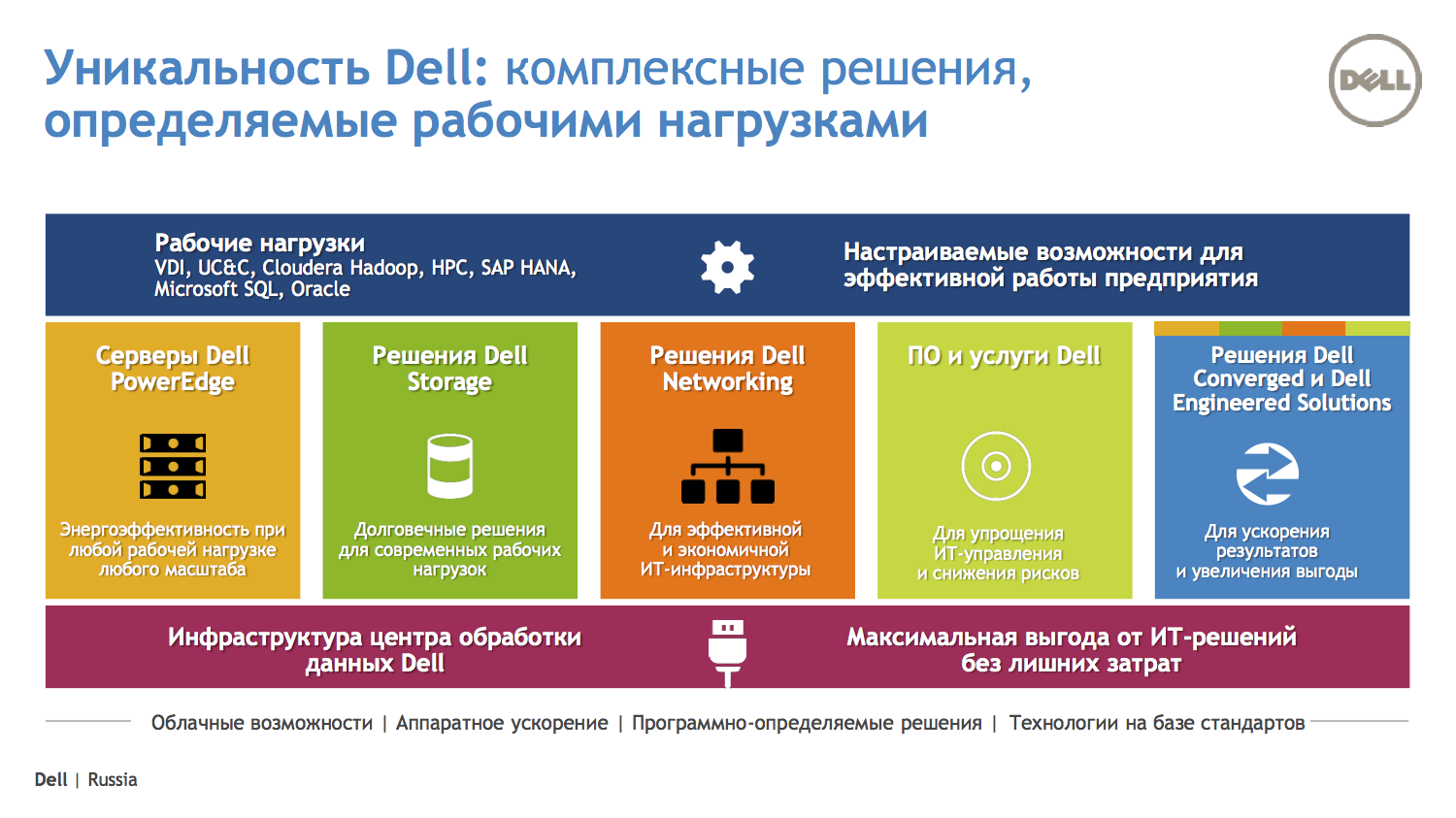
"The Evolution of Information Technology: Dell Strategy"
Key reports at the forum were made by representatives of the forum's platinum sponsors - Mario Lindner, Intel’s leading market development manager for Eastern Europe and Russia, and Pavel Betsis, Microsoft’s president of Russia.
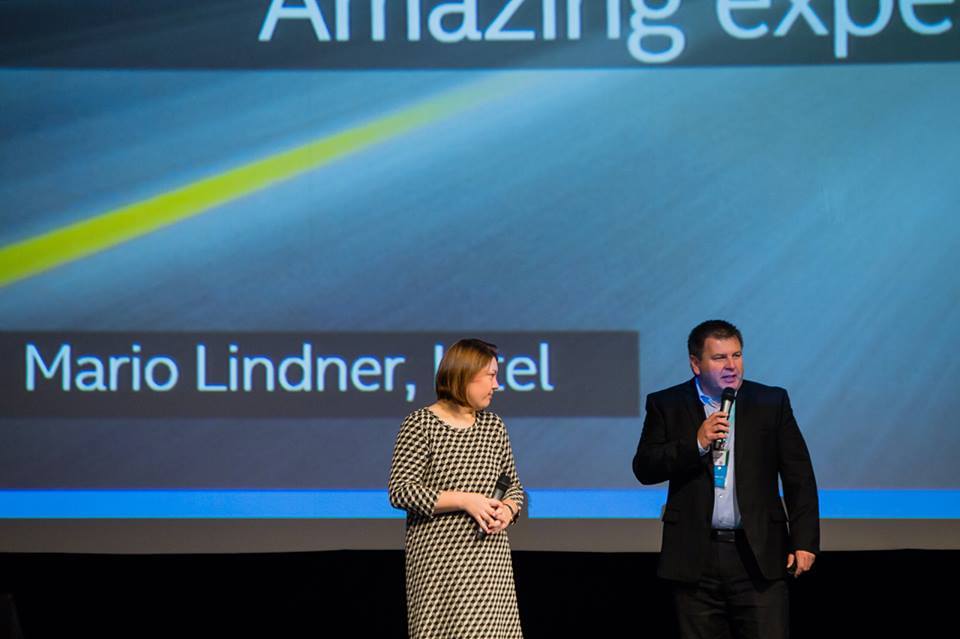
An Intel representative spoke about the rapid development of computing and the evolution of IT. So, only in the last five years, processor performance has grown 2.5 times, graphics - 30 times. And now the latest 6th generation Intel Core processors with 14nm process technology are "changing IT" again.
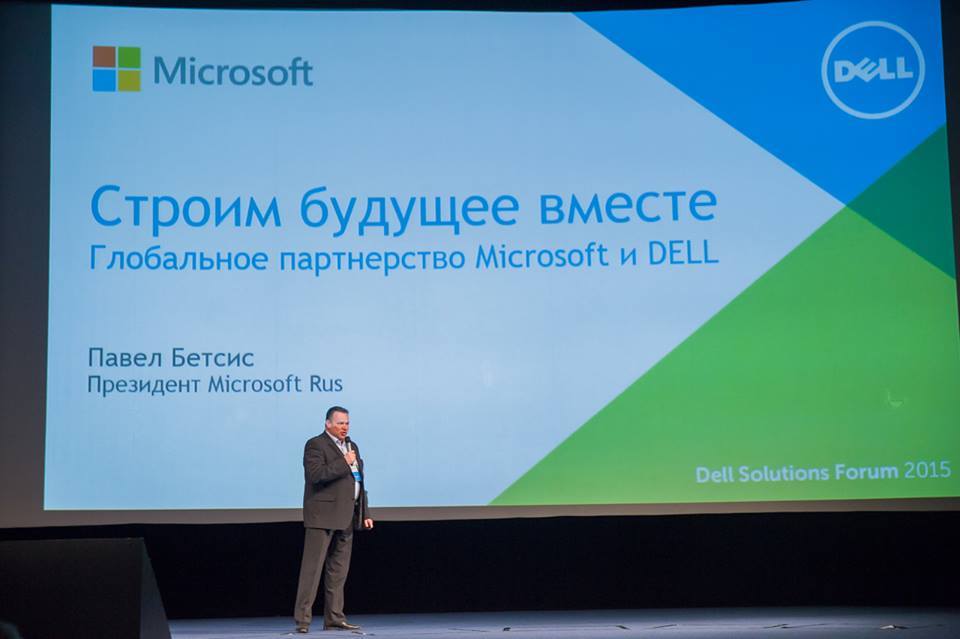
Intel Inside – Amazing Experience Outside
Pavel Betsis even called IT "a condition for the existence of civilization." It is no coincidence that in 2015 the cost of IT in the world will amount to 3.8 trillion dollars. A bright trend is the “device revolution” - by 2020, they will be read in the world by 212 billion.
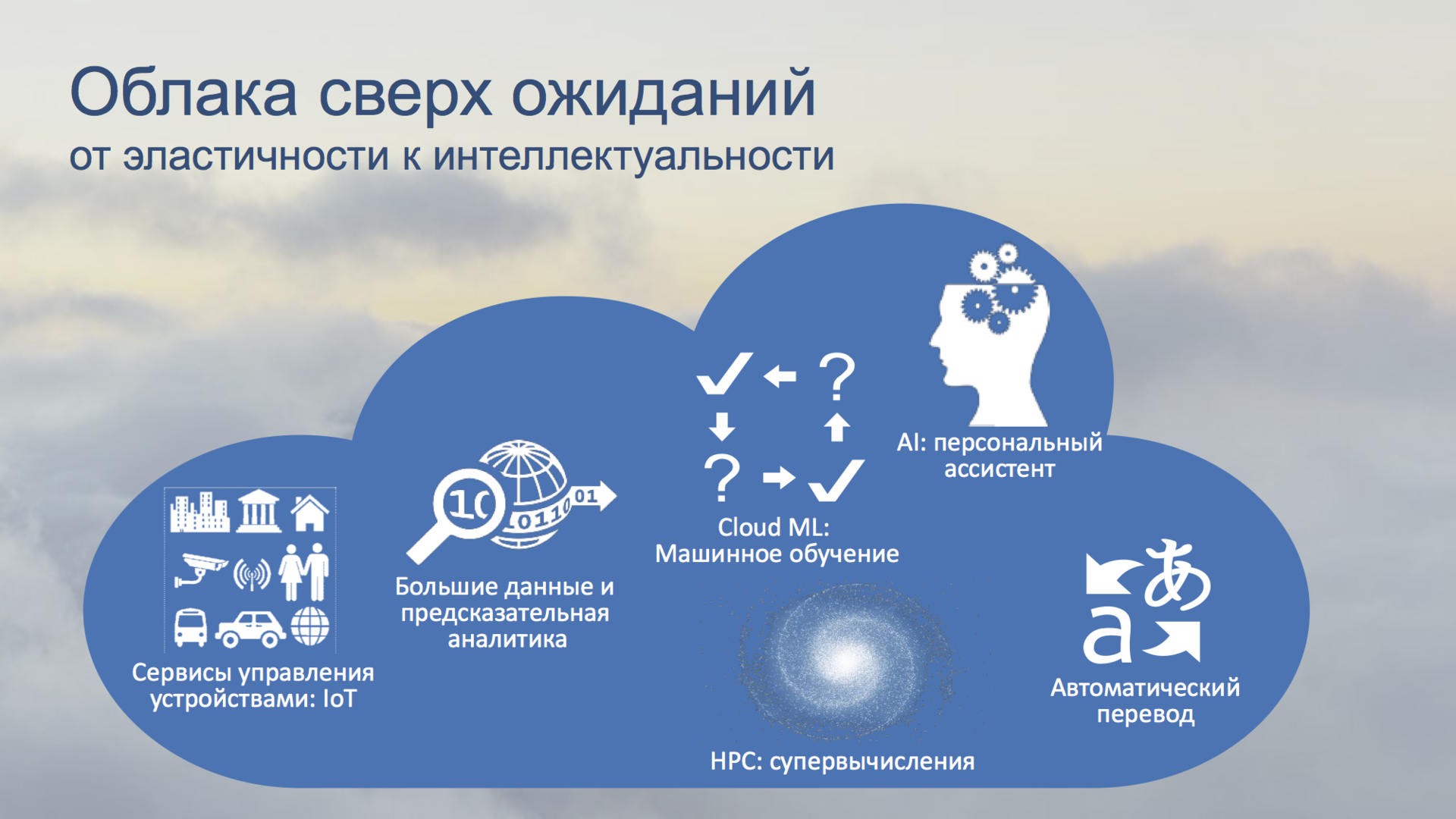
Another trend is cloud technologies, which open access to IT for small and medium-sized businesses.

Today, Microsoft and Dell are "building the future together, pushing each other's solutions."
“Building the future together: a global partnership between Microsoft and Dell”
Andrey Komarovsky, Dell Enterprise Solutions Consultant, talked about effective technologies for building VDI infrastructure .
VDI is the technology of the future, it meets modern "cloud" trends, simplifies workplace management, provides security and reliability, energy savings, remote access, easy integration with applications and OS.


One standard dual-processor server is capable of serving 100–150 VDI clients. VDI solutions pay off in about six years, in particular due to energy savings of up to 50% or more. The ThinOS operating system for Dell Wyse thin clients is only 10 MB and requires minimal hardware resources. Dell can offer a wide selection of both hardware platforms and software to solve different customer problems when building a VDI environment.
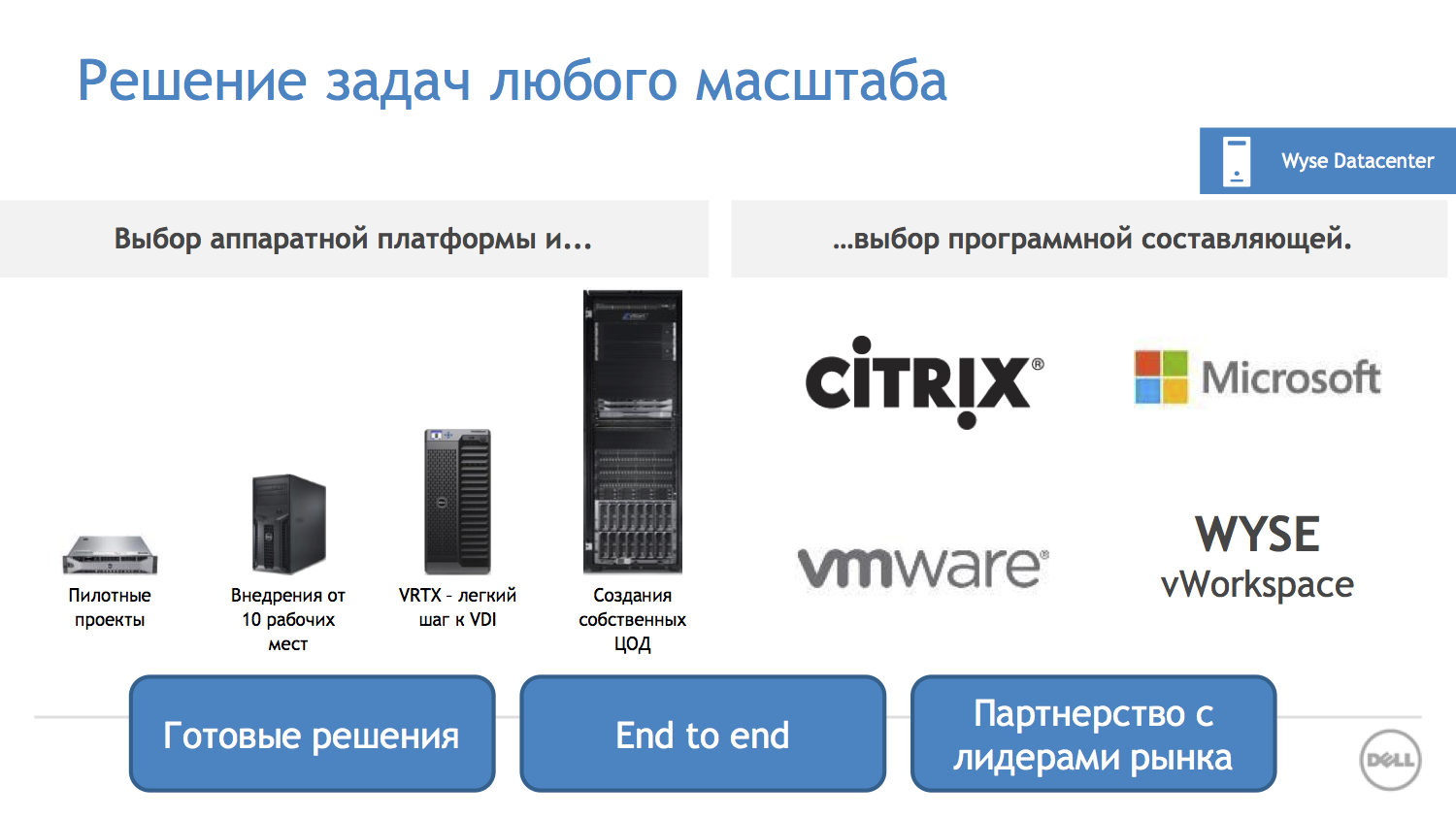
An example of the introduction of VDI in Russia was the “success story” of the Center for Simulator Engineering and Personnel Training (CTiPP), one of the leading aerospace companies in the country, which deployed a comprehensive solution for desktop virtualization based on servers, storage systems, network equipment, Dell thin and zero clients.
Vadim Yanyushkin, Deputy General Director for Technological Development of TsTiPP:
“We understood that VDI was an excellent choice. We are a small team of specialists, we wanted to simplify administration and concentrate on the development of our systems for training astronauts. ”
On the simulator, in particular, the process of docking Soyuz-TMA spacecraft with the ISS is being worked out.
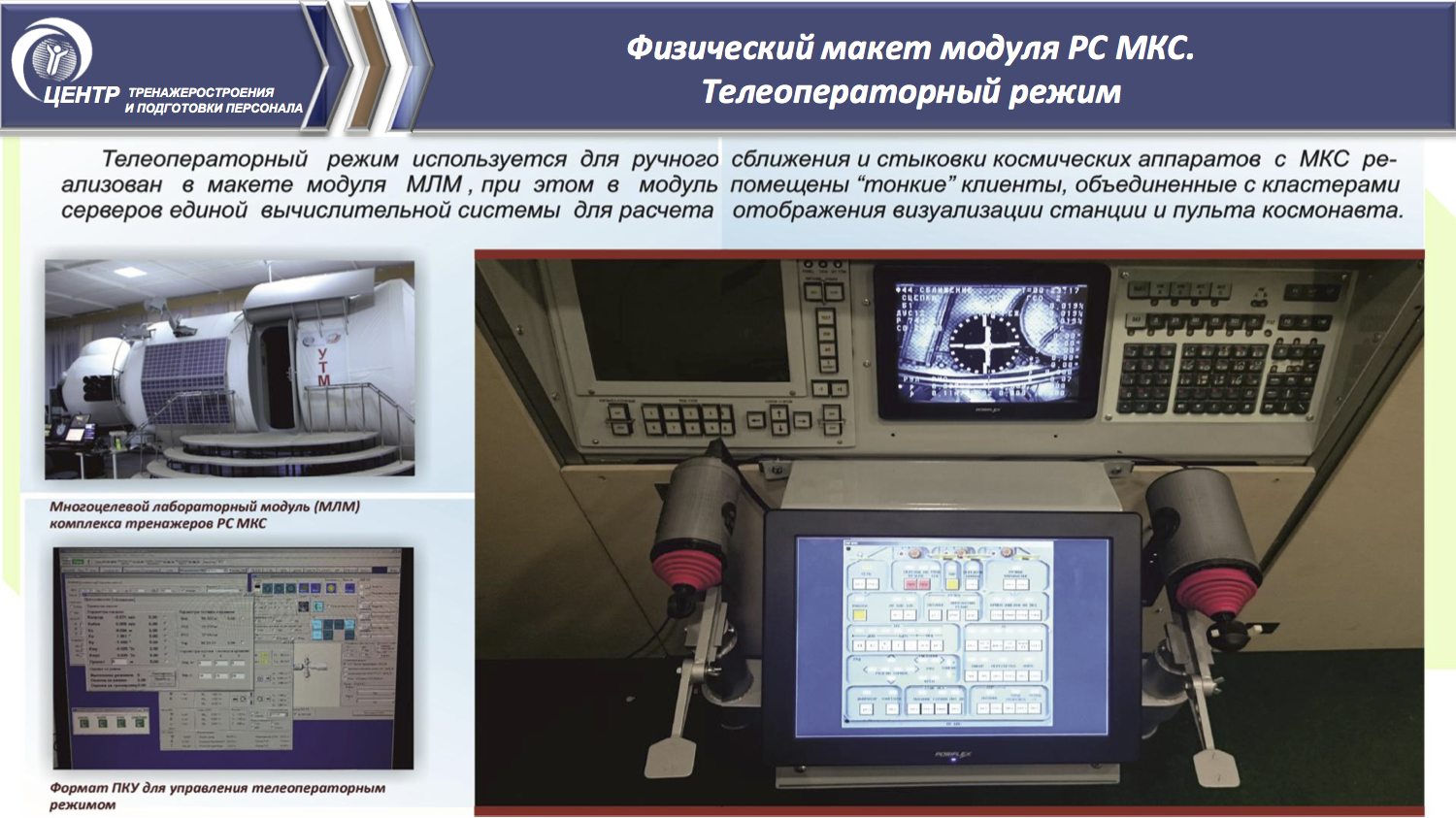
No powerful graphics stations are required for such 3D modeling. For visualization, Wyse thin clients and NVIDIA K2 graphics cards on the server are used. The software also runs on virtual machines on the server. The simulation system is based on Dell PowerEdge servers, and NVIDIA GRID technology allows multiple users to work with one graphic chip at the same time: the resources of the GPU are shared between several virtual machines. CTiPP plans to release a commercial version of such a system.

Evgeny Kim, Director of Integrated Solutions, IBS Platformix, noted that Dell is becoming the largest player in the virtualization market in general and VDI in particular. Dell VDI solutions offer such advantages as lower license costs compared to competitive solutions, cost optimization by purchasing from a single vendor and support costs, and a single virtual environment management platform. All this ultimately affects capital and operating expenses.
Today, Dell is virtually the only A-Z VDI provider, including servers, storage, desktop virtualization (Wyse vWorkplace), infrastructure monitoring and management (Dell Foglight), desktop equipment (Dell Wyse), and server virtualization (VMware )
“Profitable Wyse vWorkspace - Dell's Complete VDI Solution”
Dell's comprehensive offerings are complemented by services that play an important role in the life cycle of an IT system. These include system deployment and technical support services.

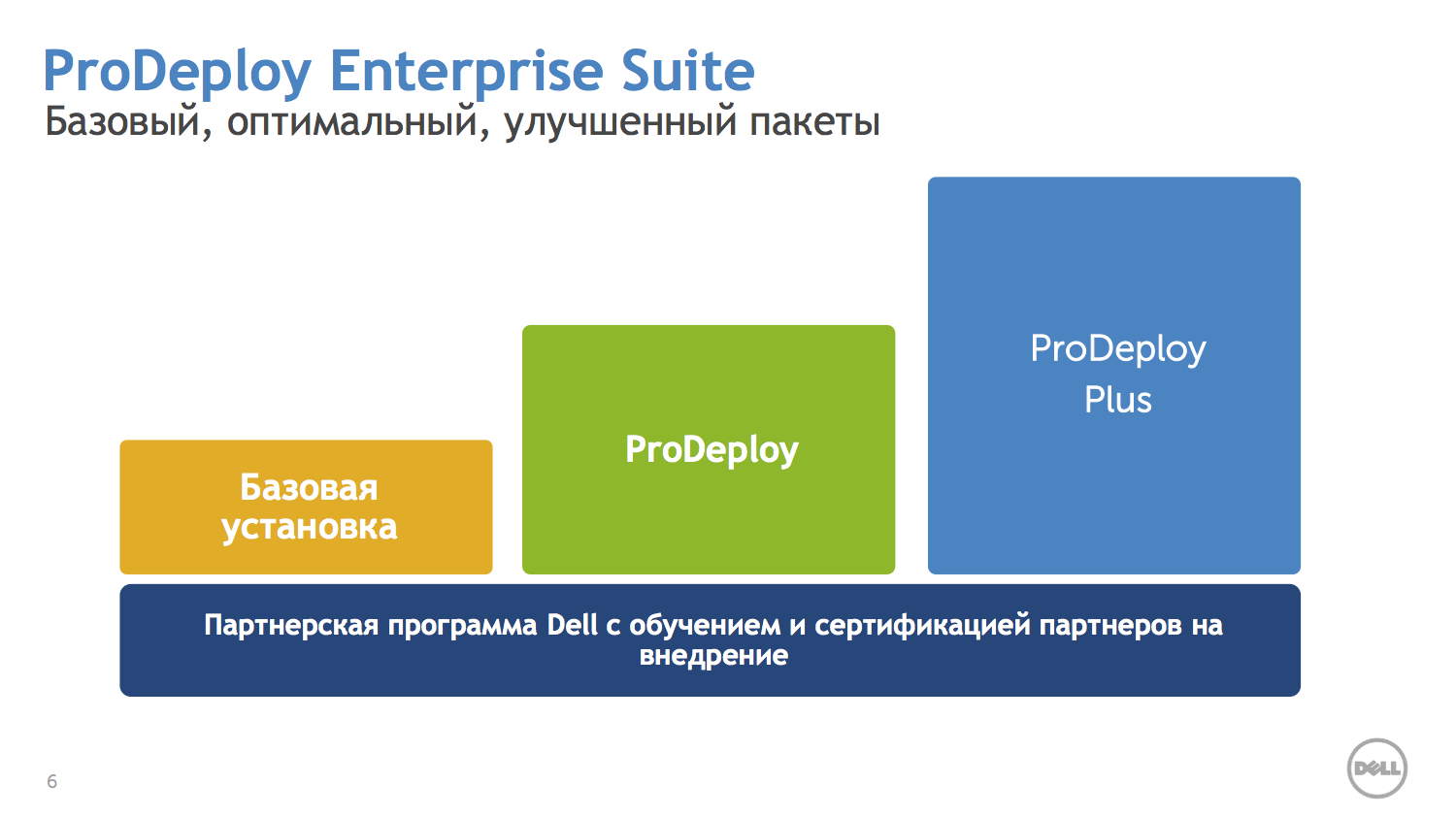
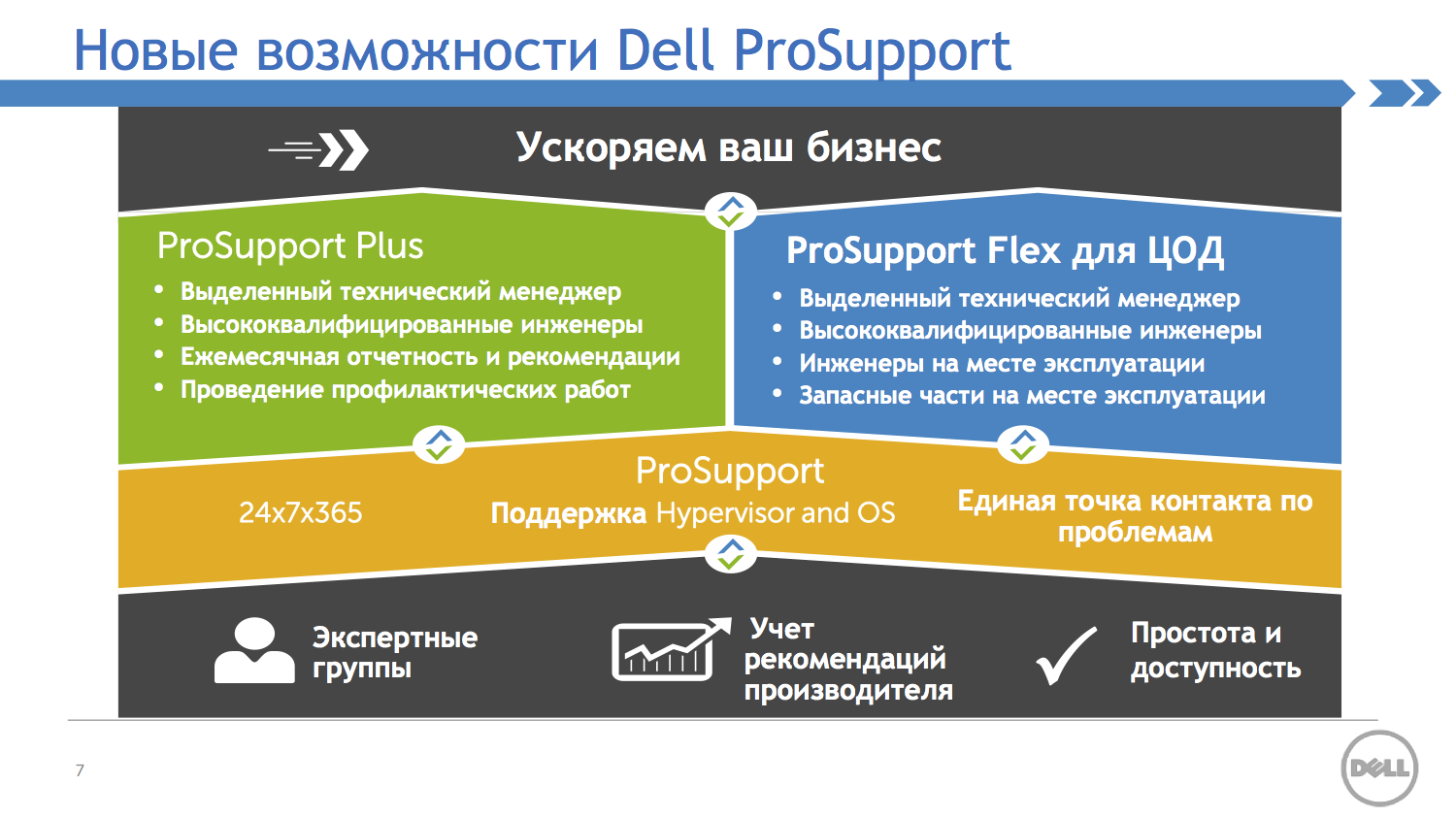
Artyom Denisyuk, Dell Service Sales Manager, highlighted services such as ProSupport and ProSupport + support, ProDeploy services offered by partners, and ProSupport Flex data center services. The latter allow you to quickly solve problems in a heterogeneous environment - this is specialized support for the entire data center, including environments from different suppliers.
Artyom also spoke about the new ProDeploy Enterprise Suite service package, expanding the proposals for the deployment and configuration of enterprise solutions. It will facilitate the transition to IT outsourcing and will allow IT departments of enterprises to focus on the main business tasks.
“New About Dell Services”
An important part of Dell's business is software. Jacob Fishelev, Dell Software's regional sales manager, introduced the company's extensive product line to conference participants.
It includes solutions that are divided into three main areas: systems management, IT security and information management.
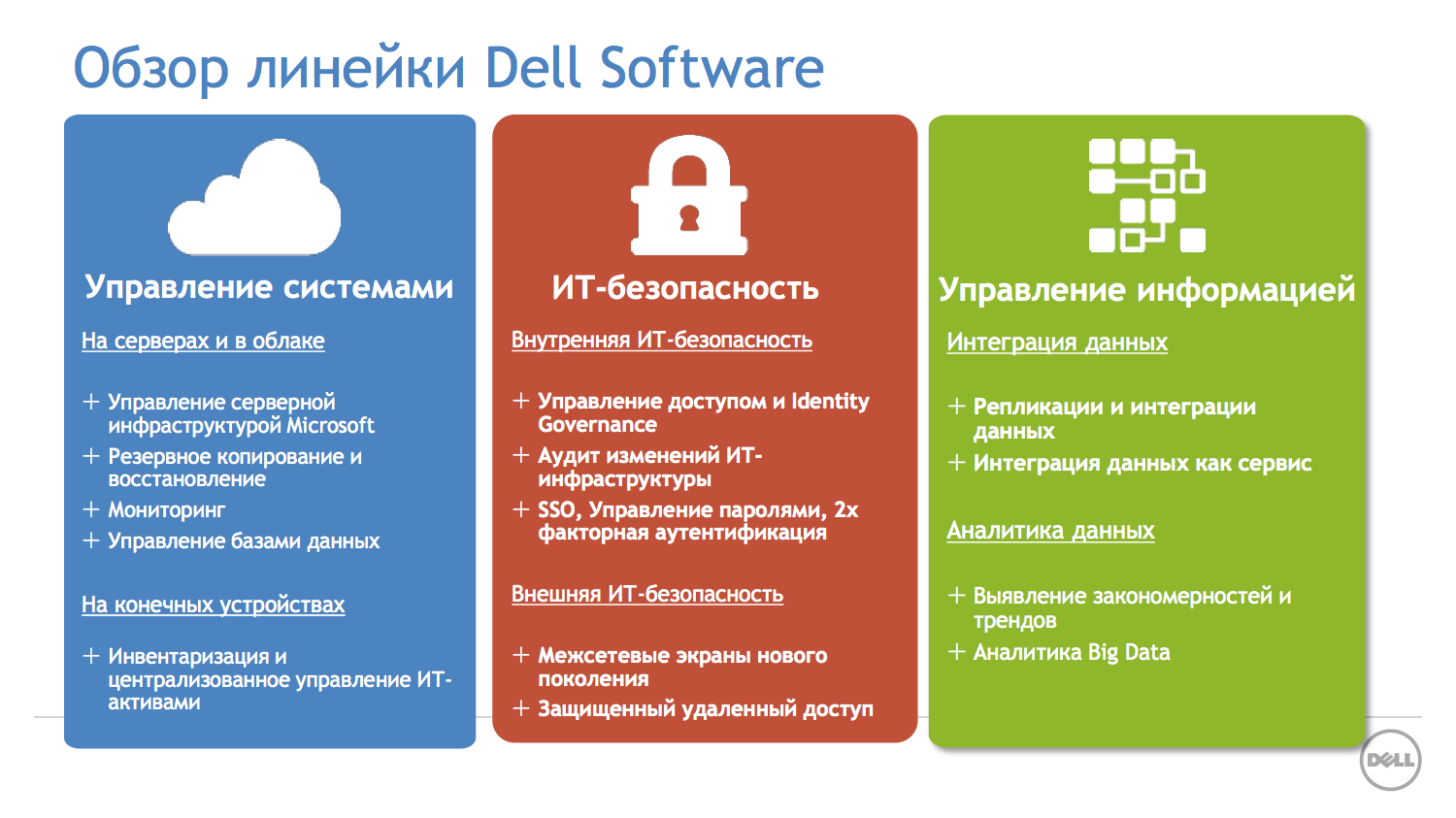
Today, Dell Software has more than 6,000 employees worldwide, over 200 products in the Dell portfolio, eight brands (Quest, SonicWALL, KACE, Boomi, Statsoft, etc.) with an annual turnover of more than $ 1.8 billion. Dell Software customers are 90% of the 1,000 largest companies in the world. In Russia, Dell Software has over a thousand customers.
The forum also presented examples of Dell Software projects implemented in Russia - the use of company developments for managing user access rights and auditing (Dell ChangeAuditor and ActiveRoles), monitoring and optimizing system performance (Dell Foglight) and integration (Dell Boomi).
“Dell Software: New Approaches. Implementation examples in Russia ”
No less interesting and important than the experience of implementing existing software solutions are new approaches. After all, they form the future of the IT industry. And today software-defined (Software Defined), or, as they are also called, software-configurable solutions - networks (SDN), storage systems (SDS) and even entire data centers (SDDC) are widely discussed.
Software-defined storages, TLC flash memory and other trends that transform the landscape of data storage technologies became the topic of the panel discussion plenary session.

As IDC polls show, around 16% of customers in the world are already investing in SDS and 36% are considering this option. Russian companies are also showing interest in software-defined storage, but so far they are looking more closely at them and trying to evaluate their benefits.
The discussion was led by Fedor Pavlov, a consultant on storage technologies at Dell in Russia, Kazakhstan and Central Asia, and Vitaly Tsybulsky, head of the infrastructure support department of NPO National Settlement Depository, Andrey Vaulin, head of the IT infrastructure department of Moscow Credit Bank, took part in it. ”, Yuri Samokhvalov, head of the server department of Svyaznoy Logistics CJSC, and Dmitry Yushkevichus, head of infrastructure and telecommunications at Clinic Management Group.
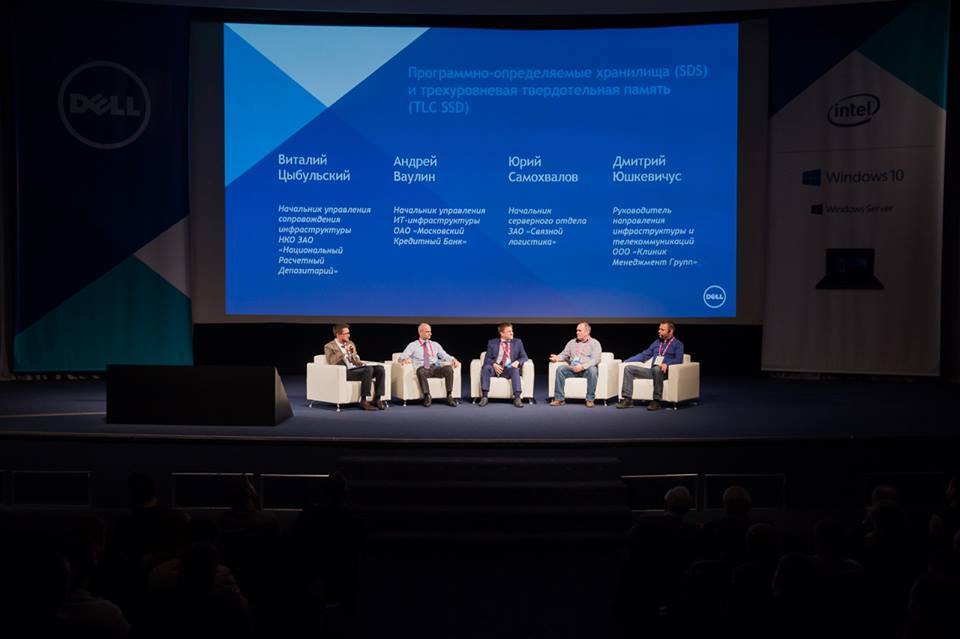
As the participants in the discussion noted, the concept of SDS with the separation of the software and hardware components of storage and using standard servers as the hardware platform has long been known. However, right now, they began to consider it as the technology of the future that can radically change the market for data storage systems. Progress in processor technologies, data storage technologies, the emergence of multi-layer solid-state flash memory, already approaching in terms of capacity and cost to hard disk drives - all this makes us take a new look at the architecture of storage systems and vendors, and customers.
Almost all of the leading manufacturers of storage systems have already presented their SDS solutions. Customers expect SDS to reduce costs and simplify administration, but at the moment they are in no hurry to deploy SDS in a production environment, the lack of maturity and reliability of the solutions raise doubts.
Although, according to IDC analysts, already in 2016, the global SDS market will reach $ 6 billion, the panelists believe that the actual implementation of software-defined storage systems will begin only after two to three years. For this, they should not concede to traditional solutions either in functionality or in reliability (after all, information is sometimes the most valuable asset of an enterprise). And, at a minimum, they should surpass them in economic indicators and ease of administration.
Dell is currently deepening partnerships with vendors of innovative SDS solutions, including Red Hat (Red Hat Storage Server based on Gluster, OpenStack and Ceph), Nexenta (NexentaStor), Microsoft (Storage Spaces), VMware (Virtual SAN and EVO: RAIL ), Nutanix (Nutanix Virtual Computing Platform). All of these solutions are installed and delivered on Dell servers optimized for these tasks.
They target different market segments. For example, the Nexenta NexentaStor task is archiving files and content, Red Hat Inktank Ceph is used to deploy large-scale XaaS applications, the Nutanix Virtual Computing Platform is a hypervisor-independent hyperconverged virtualization solution and mid-range VDI infrastructure, Microsoft Storage Spaces is intended for testing and software development for Microsoft and hosting environments, VMware VSAN and EVO: RAIL - for testing and development in VMware and deploying small-scale VDIs.
In his presentation “The New Economics of Data Storage” in the session part of the forum, Fedor Pavlov also touched on the topic of SDS. He began with the shortcomings of modern storage systems. Replacing them is difficult and time-consuming, expensive to upgrade.
But can software-defined storage systems solve the problems of the traditional financial model of storage systems?

Many customers dream of moving from specialized storage devices (applliance) to a purely software solution on standard equipment. But the software vendor is asked: what hardware does he recommend for his software, has it been tested, is there support for the hardware platform, is it possible to integrate hardware and software? The answer to these questions can only be appliance. The circle closes.
For reliable operation of the storage system, it is very important that all components of the storage system - capacity, calculator and logic - are closely soldered to each other in a single device with a single support. As a solution to the problem, Dell offers its Compellent storage systems. Their controllers are being modernized - you can move on to the next generation, moreover, on the go and with the transfer of licenses. It is possible to combine shelves of different generations (FC, SAS6, SAS12) in one system, and the gradual migration of data to new media is supported. It is no coincidence that 95% of Compellent storage systems ever sold are still under active service support.
Such an economic model corresponds to software storage systems; software is purchased once; uniform support for software and hardware is provided. Moreover, data migration, even between data centers, does not require a virtualizer. So are SDS necessary in this case?
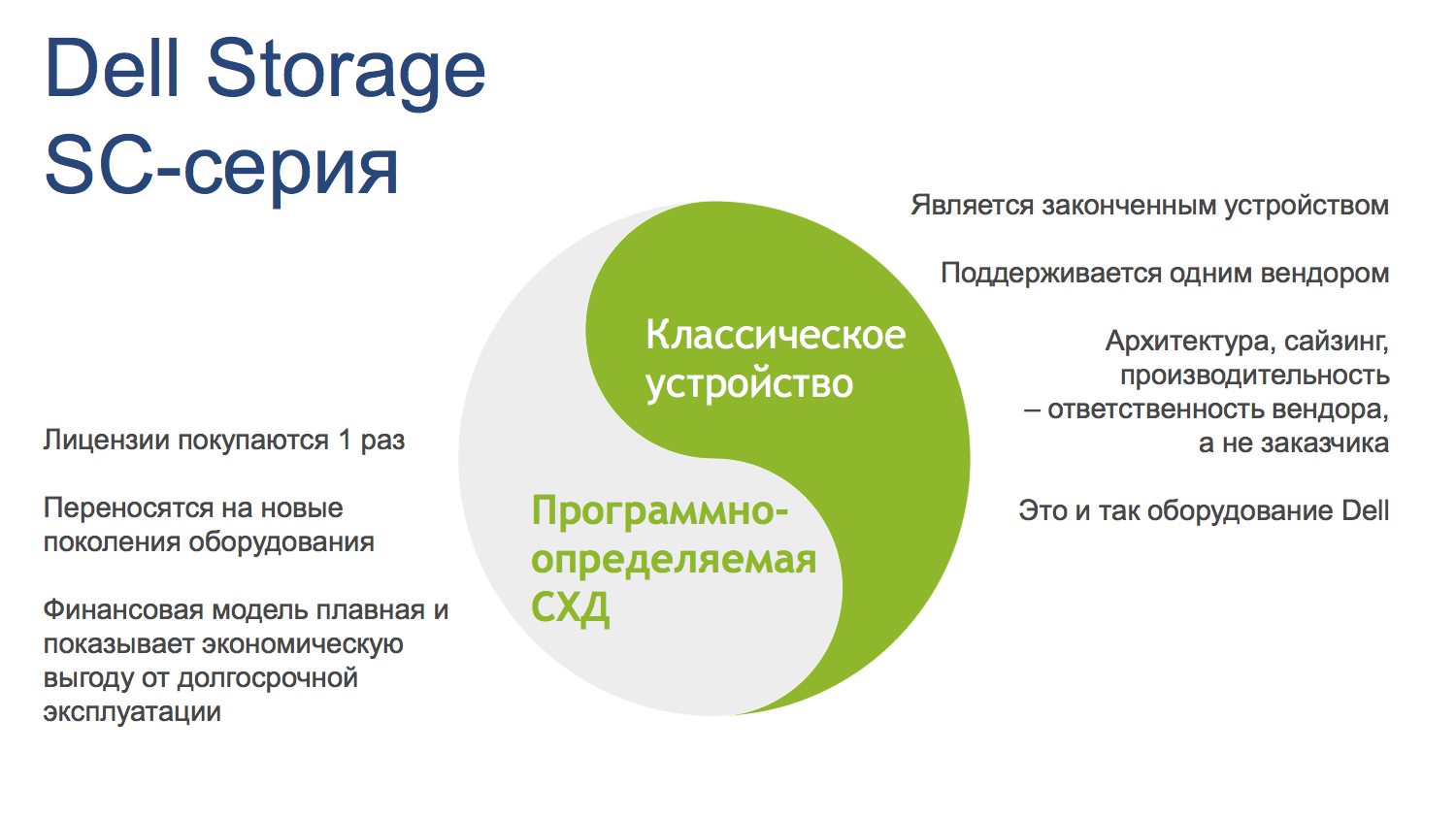
However, Dell does not stay away from the trend and, along with classic devices, offers customers an extensive portfolio of software-defined storage systems, in particular, the Dell XC series solutions. The forum participants could get to know them at the exhibition of solutions.
The New Economy of Data Storage
An interactive exhibition of Dell solutions and technology partners ran throughout the forum.
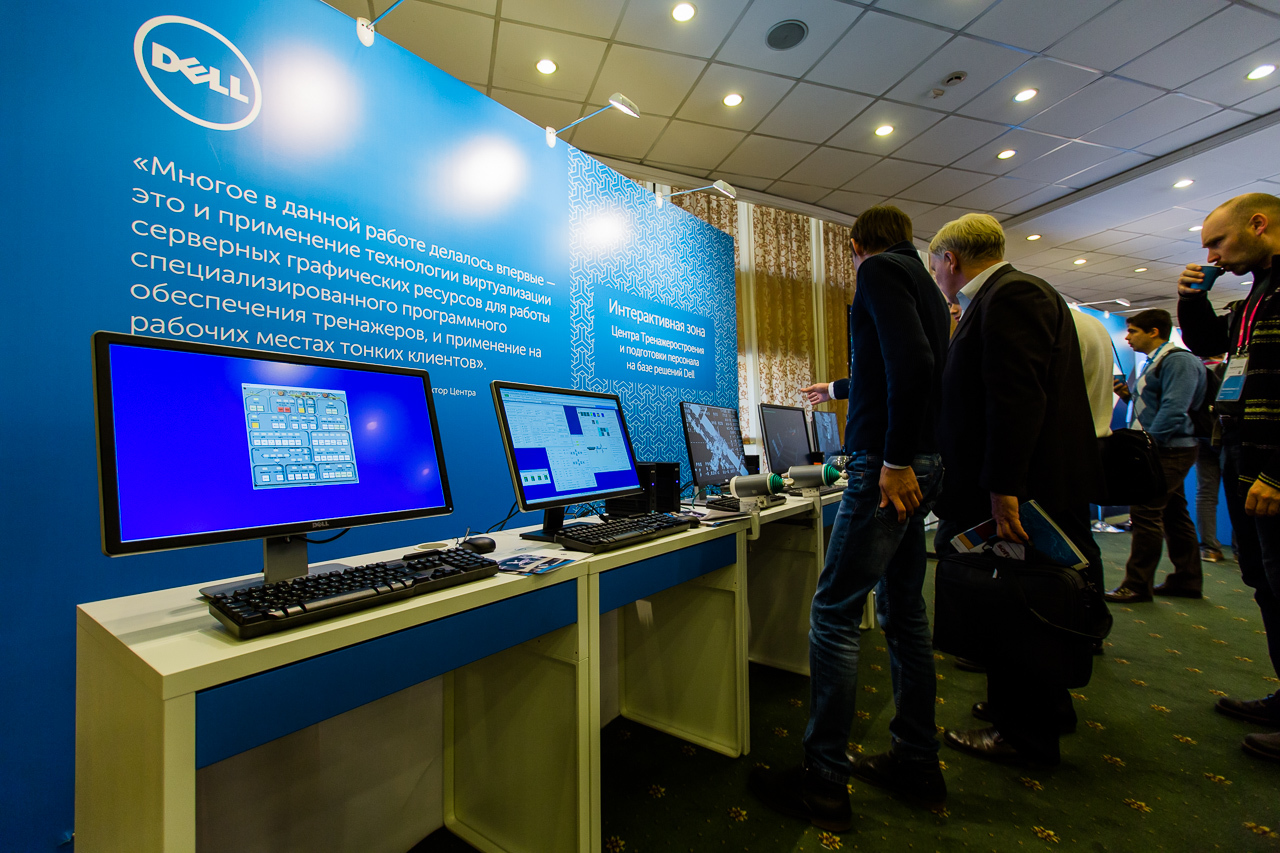
It demonstrated technologies for building a data center, mobile devices and applications for implementing personal devices in a corporate network, client systems, software solutions for centralized management of IT infrastructure, comprehensive data protection and disaster recovery, server and hyper-converged infrastructure solutions, tools for desktop virtualization .
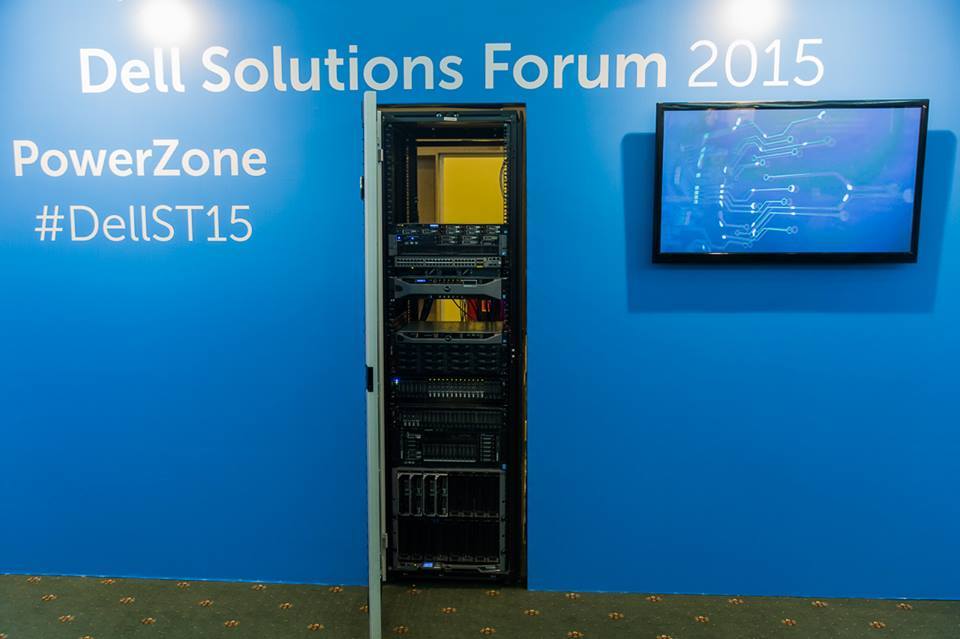
Visitors to the exhibition could get acquainted with the new 13th generation Dell PowerEdge servers, SC9000 corporate storage systems with flash drives, Dell Storage Center 6.7 software, networking equipment, laptops, tablets and thin clients, as well as a number of other products and solutions.
Denis Tropin and Andrei Komarovsky conducted a “tour of the demo zone”, stopping at each stand and talking about what was presented there.
In the interactive zone of the Center for Simulator Engineering and Personnel Training, based on Dell solutions, it was possible to test the prototypes of specialized software used in the Space Education Center, to feel like an astronaut who manually docked spacecraft.

The Big Data booth was dedicated to Dell ready-made solutions for working with Big Data and analytics tools. Fedor Pavlov spoke about a strategy for developing data storage solutions aimed at specific workloads and based on flexible modular architectures. Visitors also saw the benefits of the new Dell Storage SC storage systems.
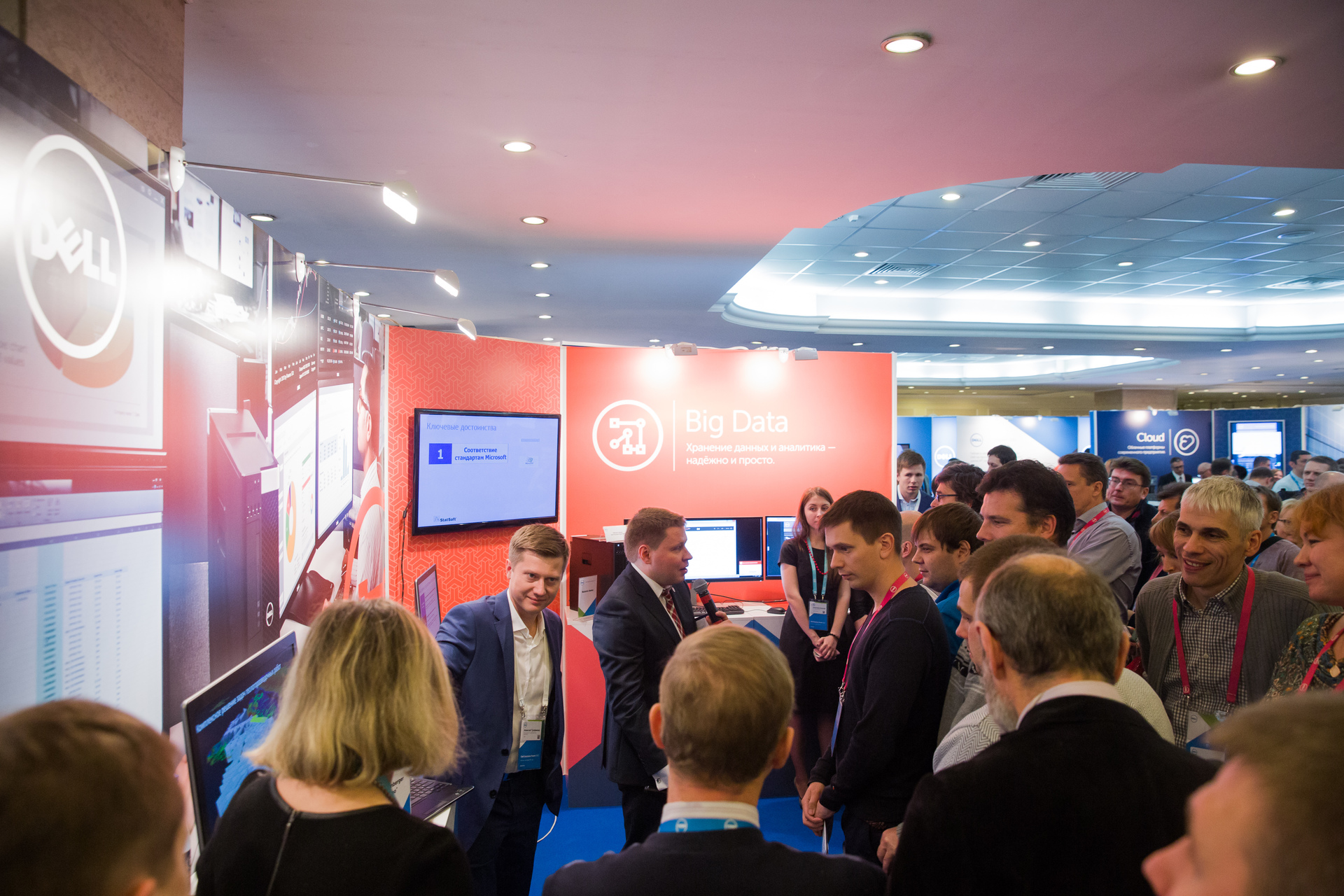
At the Big Data demo stand, an integrated solution for exploration was also presented. It is based on Dell servers, storage and client systems. Dell systems are used to build high-performance computing systems and meet the demands of demanding 3D graphics applications. Experts also talked about the capabilities of the new version of the platform for working with Big Data and analytics Dell Statistica 13.0.
Mobility solutions were presented at the Mobility exhibition area. Here you could take part in the strength tests of Latitude Rugged rugged laptops, find out what Dell Precision mobile workstations are capable of and how to use the Dell Endpoint Systems Management tools to manage the fleet of mobile devices from a single console, as well as test the performance of Dell devices - laptops , tablets, all-in-ones, and compact desktops.
In the Security demo zone, Dell integrated solutions were shown that provide security at different levels: from the gateway to the database, from the network device to the application, and from the firewall to corporate data. Solutions for access control and management, for protecting workloads on virtual machines, physical servers and in the cloud using a single application, as well as the ability to backup, replicate and restore critical data using devices based on AppAsure software, were presented to visitors.
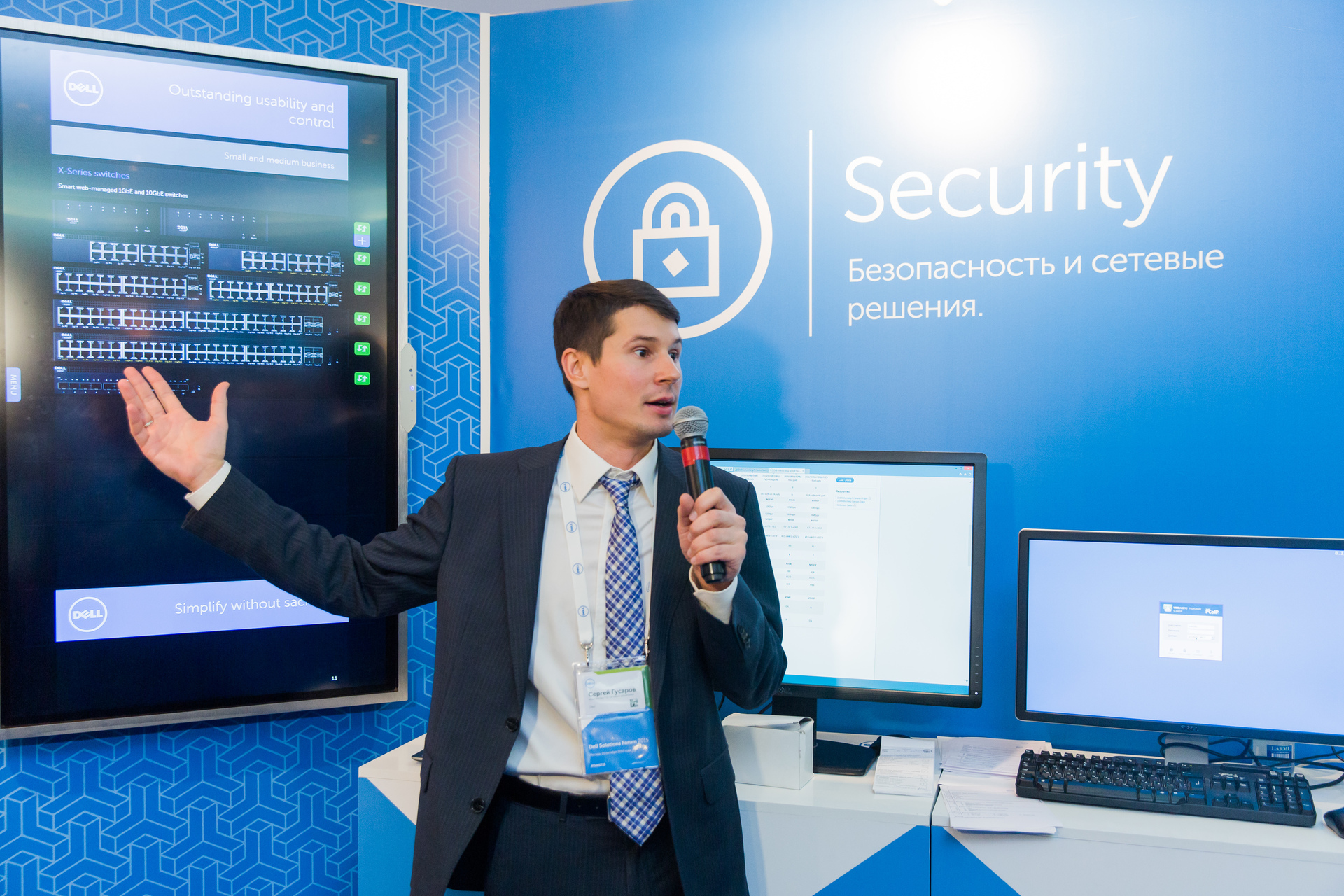
In addition, the exhibition could see the latest network equipment Dell Networking, modular switches, Open Networking solutions. Today Dell has become one of the leaders in the development of open networks, offering switches under its own brand, which can operate not only under the control of its own network operating system, but also software from other manufacturers such as Cumulus Networks, Big Switch Networks and Pluribus Networks.
Edge Gateway 5000, combined with the Statistica analytic platform, allows you to organize data preprocessing at the network edge and optimize communication channels in systems using the Internet of things technology.
The goal of the Cloud Zone is to show how Dell's cloud solutions based on open standards can optimize the data center infrastructure. Here, visitors could learn how to prepare their infrastructure for the implementation of cloud technologies, how to choose the right cloud platform, which hardware and software components should be preferred, get acquainted with joint solutions of Dell and partners for building the cloud infrastructure.
At the IBS Platformix booth, a VDI solution based on Dell vWorkspace 8.6 with video streaming optimization was deployed. System integrator IBS Platformix provides customers with a range of services related to infrastructure integration in a modern enterprise, including audit, design and development of solutions, implementation, support and support.
Citrix is one of the leaders in the transition to software-defined workstations, virtualization, mobility management, networking and software-as-a-service solutions. Citrix Solutions Help Organize Business Mobility with Secure Mobile Workstations. At the stand were presented products that provide employees with access to applications, desktops, data and communications from various devices.
Softline is a provider of IT solutions and services, it offers comprehensive IT solutions, software licensing, hardware and related services, and Softline's own cloud platform provides customers with access to public, private and hybrid clouds. Softline widely uses Dell products in its solutions, for which it has been awarded a number of awards and statuses.
Compulink presented a range of services in IT and consulting: integrated project management, IT and business consulting, construction and equipment of data centers, engineering solutions, creation of data transmission networks and unified communications, information security systems, equipment and software supply, and after-sales service. CROC's Solution Center provides customers with the ability to simulate an organization’s IT infrastructure based on Dell solutions and evaluate its effectiveness.
A wide range of solutions offered by Dell and its partner ecosystem have identified a thematic variety of reports on the forum threads, united by the slogan “IT: a step into the future”. And thematically they were organized so that the forum participants had the opportunity to study each of the areas in detail and discuss them with Dell specialists.
At the Mobility session, Dell experts talked about how to ensure employee mobility and not lose control over the infrastructure with a growing number of devices, operating systems and IT security threats, and about methods for integrating enterprise devices, applications and management services. Dell solutions help you get the most out of your employees ’personal mobile devices at work and reduce risks while protecting corporate and personal devices in a physical, virtual, and cloud environment.
Those who were interested in the topic of virtualization of workplaces learned about solving problems of organizing client workstations using virtualization, the results of many years of collaboration between Dell Wyse and Citrix in the field of building VDI, the use of Nvidia GRID 2.0 for delivering applications, and Dell solutions for building virtualization systems for 3D-graphics applications.
“Wyse vWorkspace is a budget VDI broker from Dell”,
Andrey Komarovsky, Alexander Tarasov, Dell CCC Russia.
“Desktop virtualization from Dell Wyse and Citrix is a natural choice!”,
Sergey Khalyapin, chief engineer of Citrix Systems RU & CIS,
Andrey Komarovsky, direction of Dell Wyse,
Alexander Tarasov, systems engineer of Dell Wyse.
“NVIDIA GRID 2.0 - any application on any device anywhere,”
Dmitry Konyagin, Senior Sales Manager, NVidia.
“Dell Solutions for Building 3D Virtualization Systems”,
Andrey Komarovsky, Alexander Tarasov, Dell CCC Russia.
Cloud session was dedicated to increasing IT efficiency and flexibility. It talked about how to build a cloud infrastructure on Dell solutions based on industry standards, using a universal approach that allows you to choose the platform and the provider that meet the needs of the business.
The presentations addressed the issues of “IT simplification” and increasing resource efficiency using converged infrastructure solutions, Dell integrated solutions for tomorrow’s infrastructure (including Nutanix and Nexenta), EVO: RAIL - a hyperconverged infrastructure solution from VMware and Dell, and Softline experts talked about building software-defined storage based on a metro cluster on Datacore and Dell PowerEdge. Infrastructure topics were reflected in the presentations on building new generation corporate networks based on Dell Networking solutions, monitoring the key elements of the data center as a condition for deploying cloud services.
“Simplify IT and increase recycling with converged infrastructure solutions,”
Pavel Boroch, Dell Enterprise Marketing Manager
“EVO: RAIL - Hyper-Converged Infrastructure Solution from VMware and Dell”,
Alexander Patrushev, VMware SE.
“The Datacore and Dell PowerEdge Metro Cluster as the Basis of Software Defined Storage”,
Ivan Orlov, Lead Business Development Manager, Infrastructure Solutions Department.
“Building New Generation Enterprise Networks Based on Dell Networking Solutions,”
Sergey Gusarov, Dell Networking Consultant.
Currently, Dell offers both reference architectures (blueprints) and turnkey integrated infrastructure solutions for a wide variety of tasks and loads.
“Dell End-to-End Infrastructure Solutions for Tomorrow,”
Mikhail Orlenko, Dell Technology Solutions Manager.
The topics of the Security session, as you might expect, were security issues. To ensure employee productivity and efficiency and support innovation, security technologies today must take into account the realities and established methods of work of employees, take advantage of cloud technologies, the ability to work on personal devices and mobility. Dell experts told how the company's comprehensive solutions provide the necessary level of security for data, personal information, networks and services throughout the organization.
The Big Data session focused on the effective use of analytics to transform data into knowledge. Dell's Big Data Analysis solution combines natural language processing, self-learning, and tonality analysis with easy-to-use search and visualization capabilities to gather information, identify relationships, and make the most of big data. Forum participants learned how to extract and analyze useful data in order to use this information to make more informed decisions.
The forum participants learned useful tools at presentations on investigating information security incidents, Dell data protection and storage optimization solutions, managing mobile clients using Dell KACE, predictive Big Data analytics and assessing real storage requirements in IT infrastructure using a tool DPACK.
“Dell Data Protection and Storage Optimization Solutions,”
Dmitry Krainov, Regional Business Development Manager for Russia and Kazakhstan, Dell Software.
“Dell Mobile Devices and Dell KACE Solutions for Effectively Managing Mobile Infrastructure,”
Eugene Gorshkov, Client Device Marketing Manager.
«Предиктивная аналитика и Big Data: методы, инструменты, решения»,
Марина Онищенко, исполнительный директор StatSoft Russia,
Максим Милков, технический директор StatSoft Russia. .
For example, the Dell Foglight toolkit allows you to proactively respond to growing workloads of your IT infrastructure, get clear analytics of system performance, manage congestion and predict its growth. This makes it possible to optimize the density of virtual machines in the data center, correctly configure the CPU and memory. There is also the possibility of working with a network topology, tracking communications between VMs and monitoring virtual switches vSwitch, as well as monitoring the VDI environment (VMware View).
Future versions of the product plan capacity management features for physical and virtual servers, support for Citrix XenServer and XenApp, the new generation of Hyper-V, and a SaaS version will appear for the SMB segment.
“Monitoring virtual infrastructure as a guarantee of readiness for cloud technologies”,
Dmitry Krainov, Regional Business Development Manager in Russia and Kazakhstan, Dell Software.
Another interesting and relevant solution presented to the audience was the Dell One Identity Manager (D1IM) product, designed to manage user access rights. It allows managers to view the credentials of a particular employee, easily configurable and adaptable to their needs, focused on business tasks. Employees can be empowered for a given period of time. This eliminates the causes of many incidents. And the IT Search toolkit helps organizations research logs, permissions changes, etc. to analyze security incidents. The average investigation time when analyzing more than 10 TB of data does not exceed 10 minutes. In the future, it is planned to implement data collection from a variety of sources.
“Access Pyramid” and Rapid Investigation of Information Security Incidents, ”
Konstantin Shurunov, technical partner manager, Dell Software.
In short, that's how it was. In our subjective opinion, the Dell 2015 Solution Forum came out extremely rich and interesting, you might even agree with us :)
As in the past year , we want to tell those of you who could not attend it (but really wanted to) what was happening there. Those of you who spent the whole day with us on October 21 at the Radisson Slavyanskaya Hotel are encouraged to share their impressions of the forum in the comments.

So, we invite everyone under the cat.
Even in this difficult year for all, the Forum of Solutions brought together more than 770 participants. Its sponsors are key technology partners of the company.including Intel and Microsoft. Citrix, Nvidia, VMware, Compulink, IBS Platformix, Softline and CROC also participated in the conference and exhibition.
The Moscow forum is being held as part of a series of Dell Solutions Tour 2015 events . They cover 17 countries. Speakers at the forum, and these are representatives of Dell, its partners and customers, talk about market trends, innovations and new products of the company. The goal of this event is to tell everyone about the wide range of Dell solutions that help enterprises not only optimize their existing infrastructure, but also prepare it for future growth and tomorrow's needs. Even the global marketing campaign we launched this year was called Future Ready Enterprise, and the forum itself was held under the slogan “IT: a step into the future”.
The future is today
In the film "Back to the Future - 2", the time machine transfers the protagonist precisely on October 21, 2015. This distant future seemed to the creators of the picture saturated with high-tech devices and devices, which then could only be dreamed of. The reality of 2015, of course, is different from what it was seen by director Robert Zemeckis in 1985. Flying cars and skateboards have not yet received such a distribution. But many modern technologies 30 years ago were even hard to imagine.

The main areas that determine the present and future of IT, we include technologies for cloud computing, systems to ensure employee mobility, tools to protect corporate data and user systems, technologies for working with Big data (processing, analytics and storage). So many industry experts and analysts say. Around these topics the forum program of this year was built .
Forum: Home
By tradition, the Dell Solution Forum was opened by Boris Scherbakov, Dell's CEO in Russia, Kazakhstan and Central Asia.

Two years ago, Dell, becoming a private company, got the opportunity to invest in the future - its head Michael Dell, who considers it necessary to "build a business on the needs of customers", "deployed the company to the customer."
In 2007, Michael Dell returned to the post of CEO and began transforming the corporation, spending billions of dollars to buy more than 30 companies specializing in a wide variety of fields - from networks and storage systems to software, security and clouds. Dell has begun to invest more in research and development.

“Today we are witnessing unprecedented changes in the field of information technology: the concepts of cloud computing, Big Data, mobility and security are changing our way of life, the functioning model of organizations and the picture of the world as a whole. The Dell Solutions Forum is an excellent opportunity to talk about innovative solutions from Dell and our technology partners. ”
A little about the recent successes of Dell: Gartner has included Dell among the "visionaries" in the network infrastructure of the data center. In addition, in 2014, Dell received more technology patents than in its entire history, and with its Wyse solutions, it came out on top in the global job virtualization market (VDI).
The results of Dell’s IT development activities have led to first place in high-density solutions, iSCSI devices, server virtualization, and support for the largest cloud services. Dell software is now used by 90% of Fortune 1000 companies.
It would be a long time to list all the company's achievements, but they are in the pictures and in the customer address ( Dell 2015 Annual Report to Customers ) - in pictures!
Dell offers are designed for varying degrees of "technological maturity" of customers, their willingness to introduce new technologies. A differentiated approach to customers means that they are offered both traditional and new technologies, such as software-defined and cloud solutions, Big Data analytics.

Boris Shcherbakov considers open standards, compatibility and flexibility, modularity and scalability of systems, a wide range of offers (from thin clients to servers, storage and software) and the presence of complex, converged solutions designed for different workloads to be the main factors determining Dell customers' choice. .

"The Evolution of Information Technology: Dell Strategy"
To the future - together with partners
Key reports at the forum were made by representatives of the forum's platinum sponsors - Mario Lindner, Intel’s leading market development manager for Eastern Europe and Russia, and Pavel Betsis, Microsoft’s president of Russia.

An Intel representative spoke about the rapid development of computing and the evolution of IT. So, only in the last five years, processor performance has grown 2.5 times, graphics - 30 times. And now the latest 6th generation Intel Core processors with 14nm process technology are "changing IT" again.

Intel Inside – Amazing Experience Outside
Pavel Betsis even called IT "a condition for the existence of civilization." It is no coincidence that in 2015 the cost of IT in the world will amount to 3.8 trillion dollars. A bright trend is the “device revolution” - by 2020, they will be read in the world by 212 billion.

Another trend is cloud technologies, which open access to IT for small and medium-sized businesses.

Today, Microsoft and Dell are "building the future together, pushing each other's solutions."
“Building the future together: a global partnership between Microsoft and Dell”
VDI as the technology of the future
Andrey Komarovsky, Dell Enterprise Solutions Consultant, talked about effective technologies for building VDI infrastructure .
VDI is the technology of the future, it meets modern "cloud" trends, simplifies workplace management, provides security and reliability, energy savings, remote access, easy integration with applications and OS.

“Dell offers a full range of VDI solutions: servers, storage, client systems and software. Thus, the customer can get everything from one source "."

One standard dual-processor server is capable of serving 100–150 VDI clients. VDI solutions pay off in about six years, in particular due to energy savings of up to 50% or more. The ThinOS operating system for Dell Wyse thin clients is only 10 MB and requires minimal hardware resources. Dell can offer a wide selection of both hardware platforms and software to solve different customer problems when building a VDI environment.

An example of the introduction of VDI in Russia was the “success story” of the Center for Simulator Engineering and Personnel Training (CTiPP), one of the leading aerospace companies in the country, which deployed a comprehensive solution for desktop virtualization based on servers, storage systems, network equipment, Dell thin and zero clients.
Vadim Yanyushkin, Deputy General Director for Technological Development of TsTiPP:
“We understood that VDI was an excellent choice. We are a small team of specialists, we wanted to simplify administration and concentrate on the development of our systems for training astronauts. ”
On the simulator, in particular, the process of docking Soyuz-TMA spacecraft with the ISS is being worked out.

No powerful graphics stations are required for such 3D modeling. For visualization, Wyse thin clients and NVIDIA K2 graphics cards on the server are used. The software also runs on virtual machines on the server. The simulation system is based on Dell PowerEdge servers, and NVIDIA GRID technology allows multiple users to work with one graphic chip at the same time: the resources of the GPU are shared between several virtual machines. CTiPP plans to release a commercial version of such a system.

Evgeny Kim, Director of Integrated Solutions, IBS Platformix, noted that Dell is becoming the largest player in the virtualization market in general and VDI in particular. Dell VDI solutions offer such advantages as lower license costs compared to competitive solutions, cost optimization by purchasing from a single vendor and support costs, and a single virtual environment management platform. All this ultimately affects capital and operating expenses.
Today, Dell is virtually the only A-Z VDI provider, including servers, storage, desktop virtualization (Wyse vWorkplace), infrastructure monitoring and management (Dell Foglight), desktop equipment (Dell Wyse), and server virtualization (VMware )
“Profitable Wyse vWorkspace - Dell's Complete VDI Solution”
Service & Support
Dell's comprehensive offerings are complemented by services that play an important role in the life cycle of an IT system. These include system deployment and technical support services.



Artyom Denisyuk, Dell Service Sales Manager, highlighted services such as ProSupport and ProSupport + support, ProDeploy services offered by partners, and ProSupport Flex data center services. The latter allow you to quickly solve problems in a heterogeneous environment - this is specialized support for the entire data center, including environments from different suppliers.
Artyom also spoke about the new ProDeploy Enterprise Suite service package, expanding the proposals for the deployment and configuration of enterprise solutions. It will facilitate the transition to IT outsourcing and will allow IT departments of enterprises to focus on the main business tasks.
“New About Dell Services”
Not Just Iron: Dell Software
An important part of Dell's business is software. Jacob Fishelev, Dell Software's regional sales manager, introduced the company's extensive product line to conference participants.
It includes solutions that are divided into three main areas: systems management, IT security and information management.

Today, Dell Software has more than 6,000 employees worldwide, over 200 products in the Dell portfolio, eight brands (Quest, SonicWALL, KACE, Boomi, Statsoft, etc.) with an annual turnover of more than $ 1.8 billion. Dell Software customers are 90% of the 1,000 largest companies in the world. In Russia, Dell Software has over a thousand customers.
The forum also presented examples of Dell Software projects implemented in Russia - the use of company developments for managing user access rights and auditing (Dell ChangeAuditor and ActiveRoles), monitoring and optimizing system performance (Dell Foglight) and integration (Dell Boomi).
“Dell Software: New Approaches. Implementation examples in Russia ”
No less interesting and important than the experience of implementing existing software solutions are new approaches. After all, they form the future of the IT industry. And today software-defined (Software Defined), or, as they are also called, software-configurable solutions - networks (SDN), storage systems (SDS) and even entire data centers (SDDC) are widely discussed.
Software Defined Storage
Software-defined storages, TLC flash memory and other trends that transform the landscape of data storage technologies became the topic of the panel discussion plenary session.

As IDC polls show, around 16% of customers in the world are already investing in SDS and 36% are considering this option. Russian companies are also showing interest in software-defined storage, but so far they are looking more closely at them and trying to evaluate their benefits.
The discussion was led by Fedor Pavlov, a consultant on storage technologies at Dell in Russia, Kazakhstan and Central Asia, and Vitaly Tsybulsky, head of the infrastructure support department of NPO National Settlement Depository, Andrey Vaulin, head of the IT infrastructure department of Moscow Credit Bank, took part in it. ”, Yuri Samokhvalov, head of the server department of Svyaznoy Logistics CJSC, and Dmitry Yushkevichus, head of infrastructure and telecommunications at Clinic Management Group.

As the participants in the discussion noted, the concept of SDS with the separation of the software and hardware components of storage and using standard servers as the hardware platform has long been known. However, right now, they began to consider it as the technology of the future that can radically change the market for data storage systems. Progress in processor technologies, data storage technologies, the emergence of multi-layer solid-state flash memory, already approaching in terms of capacity and cost to hard disk drives - all this makes us take a new look at the architecture of storage systems and vendors, and customers.
Almost all of the leading manufacturers of storage systems have already presented their SDS solutions. Customers expect SDS to reduce costs and simplify administration, but at the moment they are in no hurry to deploy SDS in a production environment, the lack of maturity and reliability of the solutions raise doubts.
Although, according to IDC analysts, already in 2016, the global SDS market will reach $ 6 billion, the panelists believe that the actual implementation of software-defined storage systems will begin only after two to three years. For this, they should not concede to traditional solutions either in functionality or in reliability (after all, information is sometimes the most valuable asset of an enterprise). And, at a minimum, they should surpass them in economic indicators and ease of administration.
Dell is currently deepening partnerships with vendors of innovative SDS solutions, including Red Hat (Red Hat Storage Server based on Gluster, OpenStack and Ceph), Nexenta (NexentaStor), Microsoft (Storage Spaces), VMware (Virtual SAN and EVO: RAIL ), Nutanix (Nutanix Virtual Computing Platform). All of these solutions are installed and delivered on Dell servers optimized for these tasks.
They target different market segments. For example, the Nexenta NexentaStor task is archiving files and content, Red Hat Inktank Ceph is used to deploy large-scale XaaS applications, the Nutanix Virtual Computing Platform is a hypervisor-independent hyperconverged virtualization solution and mid-range VDI infrastructure, Microsoft Storage Spaces is intended for testing and software development for Microsoft and hosting environments, VMware VSAN and EVO: RAIL - for testing and development in VMware and deploying small-scale VDIs.
SDS and not SDS: Storage Economics
In his presentation “The New Economics of Data Storage” in the session part of the forum, Fedor Pavlov also touched on the topic of SDS. He began with the shortcomings of modern storage systems. Replacing them is difficult and time-consuming, expensive to upgrade.
“By and large, the whole problem is that the storage system is still regarded as a device, moreover, a device with a limited service life, without any development and modernization strategy. Need a storage platform, not a device. The approach to storage systems as a device leads to a ruinous storage model. Modernization is sometimes impossible even in the storage of one generation. "The current financial model can be significantly improved if we switch to a storage platform in which software and hardware are abstracted from each other."
But can software-defined storage systems solve the problems of the traditional financial model of storage systems?

Many customers dream of moving from specialized storage devices (applliance) to a purely software solution on standard equipment. But the software vendor is asked: what hardware does he recommend for his software, has it been tested, is there support for the hardware platform, is it possible to integrate hardware and software? The answer to these questions can only be appliance. The circle closes.
For reliable operation of the storage system, it is very important that all components of the storage system - capacity, calculator and logic - are closely soldered to each other in a single device with a single support. As a solution to the problem, Dell offers its Compellent storage systems. Their controllers are being modernized - you can move on to the next generation, moreover, on the go and with the transfer of licenses. It is possible to combine shelves of different generations (FC, SAS6, SAS12) in one system, and the gradual migration of data to new media is supported. It is no coincidence that 95% of Compellent storage systems ever sold are still under active service support.
Such an economic model corresponds to software storage systems; software is purchased once; uniform support for software and hardware is provided. Moreover, data migration, even between data centers, does not require a virtualizer. So are SDS necessary in this case?

However, Dell does not stay away from the trend and, along with classic devices, offers customers an extensive portfolio of software-defined storage systems, in particular, the Dell XC series solutions. The forum participants could get to know them at the exhibition of solutions.
The New Economy of Data Storage
Exhibition of Solutions: Big Data, Mobility, Security, Cloud
An interactive exhibition of Dell solutions and technology partners ran throughout the forum.

It demonstrated technologies for building a data center, mobile devices and applications for implementing personal devices in a corporate network, client systems, software solutions for centralized management of IT infrastructure, comprehensive data protection and disaster recovery, server and hyper-converged infrastructure solutions, tools for desktop virtualization .

Visitors to the exhibition could get acquainted with the new 13th generation Dell PowerEdge servers, SC9000 corporate storage systems with flash drives, Dell Storage Center 6.7 software, networking equipment, laptops, tablets and thin clients, as well as a number of other products and solutions.
Denis Tropin and Andrei Komarovsky conducted a “tour of the demo zone”, stopping at each stand and talking about what was presented there.
In the interactive zone of the Center for Simulator Engineering and Personnel Training, based on Dell solutions, it was possible to test the prototypes of specialized software used in the Space Education Center, to feel like an astronaut who manually docked spacecraft.

The Big Data booth was dedicated to Dell ready-made solutions for working with Big Data and analytics tools. Fedor Pavlov spoke about a strategy for developing data storage solutions aimed at specific workloads and based on flexible modular architectures. Visitors also saw the benefits of the new Dell Storage SC storage systems.

At the Big Data demo stand, an integrated solution for exploration was also presented. It is based on Dell servers, storage and client systems. Dell systems are used to build high-performance computing systems and meet the demands of demanding 3D graphics applications. Experts also talked about the capabilities of the new version of the platform for working with Big Data and analytics Dell Statistica 13.0.
Mobility solutions were presented at the Mobility exhibition area. Here you could take part in the strength tests of Latitude Rugged rugged laptops, find out what Dell Precision mobile workstations are capable of and how to use the Dell Endpoint Systems Management tools to manage the fleet of mobile devices from a single console, as well as test the performance of Dell devices - laptops , tablets, all-in-ones, and compact desktops.
In the Security demo zone, Dell integrated solutions were shown that provide security at different levels: from the gateway to the database, from the network device to the application, and from the firewall to corporate data. Solutions for access control and management, for protecting workloads on virtual machines, physical servers and in the cloud using a single application, as well as the ability to backup, replicate and restore critical data using devices based on AppAsure software, were presented to visitors.

In addition, the exhibition could see the latest network equipment Dell Networking, modular switches, Open Networking solutions. Today Dell has become one of the leaders in the development of open networks, offering switches under its own brand, which can operate not only under the control of its own network operating system, but also software from other manufacturers such as Cumulus Networks, Big Switch Networks and Pluribus Networks.
Edge Gateway 5000, combined with the Statistica analytic platform, allows you to organize data preprocessing at the network edge and optimize communication channels in systems using the Internet of things technology.
The goal of the Cloud Zone is to show how Dell's cloud solutions based on open standards can optimize the data center infrastructure. Here, visitors could learn how to prepare their infrastructure for the implementation of cloud technologies, how to choose the right cloud platform, which hardware and software components should be preferred, get acquainted with joint solutions of Dell and partners for building the cloud infrastructure.
At the IBS Platformix booth, a VDI solution based on Dell vWorkspace 8.6 with video streaming optimization was deployed. System integrator IBS Platformix provides customers with a range of services related to infrastructure integration in a modern enterprise, including audit, design and development of solutions, implementation, support and support.
Citrix is one of the leaders in the transition to software-defined workstations, virtualization, mobility management, networking and software-as-a-service solutions. Citrix Solutions Help Organize Business Mobility with Secure Mobile Workstations. At the stand were presented products that provide employees with access to applications, desktops, data and communications from various devices.
Softline is a provider of IT solutions and services, it offers comprehensive IT solutions, software licensing, hardware and related services, and Softline's own cloud platform provides customers with access to public, private and hybrid clouds. Softline widely uses Dell products in its solutions, for which it has been awarded a number of awards and statuses.
Compulink presented a range of services in IT and consulting: integrated project management, IT and business consulting, construction and equipment of data centers, engineering solutions, creation of data transmission networks and unified communications, information security systems, equipment and software supply, and after-sales service. CROC's Solution Center provides customers with the ability to simulate an organization’s IT infrastructure based on Dell solutions and evaluate its effectiveness.
Step into the Future
A wide range of solutions offered by Dell and its partner ecosystem have identified a thematic variety of reports on the forum threads, united by the slogan “IT: a step into the future”. And thematically they were organized so that the forum participants had the opportunity to study each of the areas in detail and discuss them with Dell specialists.
At the Mobility session, Dell experts talked about how to ensure employee mobility and not lose control over the infrastructure with a growing number of devices, operating systems and IT security threats, and about methods for integrating enterprise devices, applications and management services. Dell solutions help you get the most out of your employees ’personal mobile devices at work and reduce risks while protecting corporate and personal devices in a physical, virtual, and cloud environment.
Those who were interested in the topic of virtualization of workplaces learned about solving problems of organizing client workstations using virtualization, the results of many years of collaboration between Dell Wyse and Citrix in the field of building VDI, the use of Nvidia GRID 2.0 for delivering applications, and Dell solutions for building virtualization systems for 3D-graphics applications.
“Wyse vWorkspace is a budget VDI broker from Dell”,
Andrey Komarovsky, Alexander Tarasov, Dell CCC Russia.
“Desktop virtualization from Dell Wyse and Citrix is a natural choice!”,
Sergey Khalyapin, chief engineer of Citrix Systems RU & CIS,
Andrey Komarovsky, direction of Dell Wyse,
Alexander Tarasov, systems engineer of Dell Wyse.
“NVIDIA GRID 2.0 - any application on any device anywhere,”
Dmitry Konyagin, Senior Sales Manager, NVidia.
“Dell Solutions for Building 3D Virtualization Systems”,
Andrey Komarovsky, Alexander Tarasov, Dell CCC Russia.
Cloud session was dedicated to increasing IT efficiency and flexibility. It talked about how to build a cloud infrastructure on Dell solutions based on industry standards, using a universal approach that allows you to choose the platform and the provider that meet the needs of the business.
The presentations addressed the issues of “IT simplification” and increasing resource efficiency using converged infrastructure solutions, Dell integrated solutions for tomorrow’s infrastructure (including Nutanix and Nexenta), EVO: RAIL - a hyperconverged infrastructure solution from VMware and Dell, and Softline experts talked about building software-defined storage based on a metro cluster on Datacore and Dell PowerEdge. Infrastructure topics were reflected in the presentations on building new generation corporate networks based on Dell Networking solutions, monitoring the key elements of the data center as a condition for deploying cloud services.
“Simplify IT and increase recycling with converged infrastructure solutions,”
Pavel Boroch, Dell Enterprise Marketing Manager
“EVO: RAIL - Hyper-Converged Infrastructure Solution from VMware and Dell”,
Alexander Patrushev, VMware SE.
“The Datacore and Dell PowerEdge Metro Cluster as the Basis of Software Defined Storage”,
Ivan Orlov, Lead Business Development Manager, Infrastructure Solutions Department.
“Building New Generation Enterprise Networks Based on Dell Networking Solutions,”
Sergey Gusarov, Dell Networking Consultant.
Currently, Dell offers both reference architectures (blueprints) and turnkey integrated infrastructure solutions for a wide variety of tasks and loads.
“Dell End-to-End Infrastructure Solutions for Tomorrow,”
Mikhail Orlenko, Dell Technology Solutions Manager.
The topics of the Security session, as you might expect, were security issues. To ensure employee productivity and efficiency and support innovation, security technologies today must take into account the realities and established methods of work of employees, take advantage of cloud technologies, the ability to work on personal devices and mobility. Dell experts told how the company's comprehensive solutions provide the necessary level of security for data, personal information, networks and services throughout the organization.
The Big Data session focused on the effective use of analytics to transform data into knowledge. Dell's Big Data Analysis solution combines natural language processing, self-learning, and tonality analysis with easy-to-use search and visualization capabilities to gather information, identify relationships, and make the most of big data. Forum participants learned how to extract and analyze useful data in order to use this information to make more informed decisions.
The forum participants learned useful tools at presentations on investigating information security incidents, Dell data protection and storage optimization solutions, managing mobile clients using Dell KACE, predictive Big Data analytics and assessing real storage requirements in IT infrastructure using a tool DPACK.
“Dell Data Protection and Storage Optimization Solutions,”
Dmitry Krainov, Regional Business Development Manager for Russia and Kazakhstan, Dell Software.
“Dell Mobile Devices and Dell KACE Solutions for Effectively Managing Mobile Infrastructure,”
Eugene Gorshkov, Client Device Marketing Manager.
«Предиктивная аналитика и Big Data: методы, инструменты, решения»,
Марина Онищенко, исполнительный директор StatSoft Russia,
Максим Милков, технический директор StatSoft Russia. .
For example, the Dell Foglight toolkit allows you to proactively respond to growing workloads of your IT infrastructure, get clear analytics of system performance, manage congestion and predict its growth. This makes it possible to optimize the density of virtual machines in the data center, correctly configure the CPU and memory. There is also the possibility of working with a network topology, tracking communications between VMs and monitoring virtual switches vSwitch, as well as monitoring the VDI environment (VMware View).
Future versions of the product plan capacity management features for physical and virtual servers, support for Citrix XenServer and XenApp, the new generation of Hyper-V, and a SaaS version will appear for the SMB segment.
“Monitoring virtual infrastructure as a guarantee of readiness for cloud technologies”,
Dmitry Krainov, Regional Business Development Manager in Russia and Kazakhstan, Dell Software.
Another interesting and relevant solution presented to the audience was the Dell One Identity Manager (D1IM) product, designed to manage user access rights. It allows managers to view the credentials of a particular employee, easily configurable and adaptable to their needs, focused on business tasks. Employees can be empowered for a given period of time. This eliminates the causes of many incidents. And the IT Search toolkit helps organizations research logs, permissions changes, etc. to analyze security incidents. The average investigation time when analyzing more than 10 TB of data does not exceed 10 minutes. In the future, it is planned to implement data collection from a variety of sources.
“Access Pyramid” and Rapid Investigation of Information Security Incidents, ”
Konstantin Shurunov, technical partner manager, Dell Software.
In short, that's how it was. In our subjective opinion, the Dell 2015 Solution Forum came out extremely rich and interesting, you might even agree with us :)
